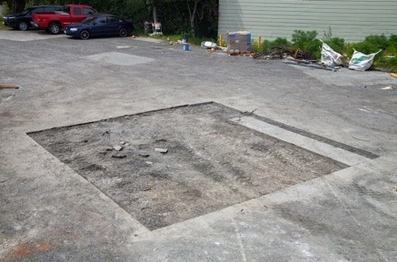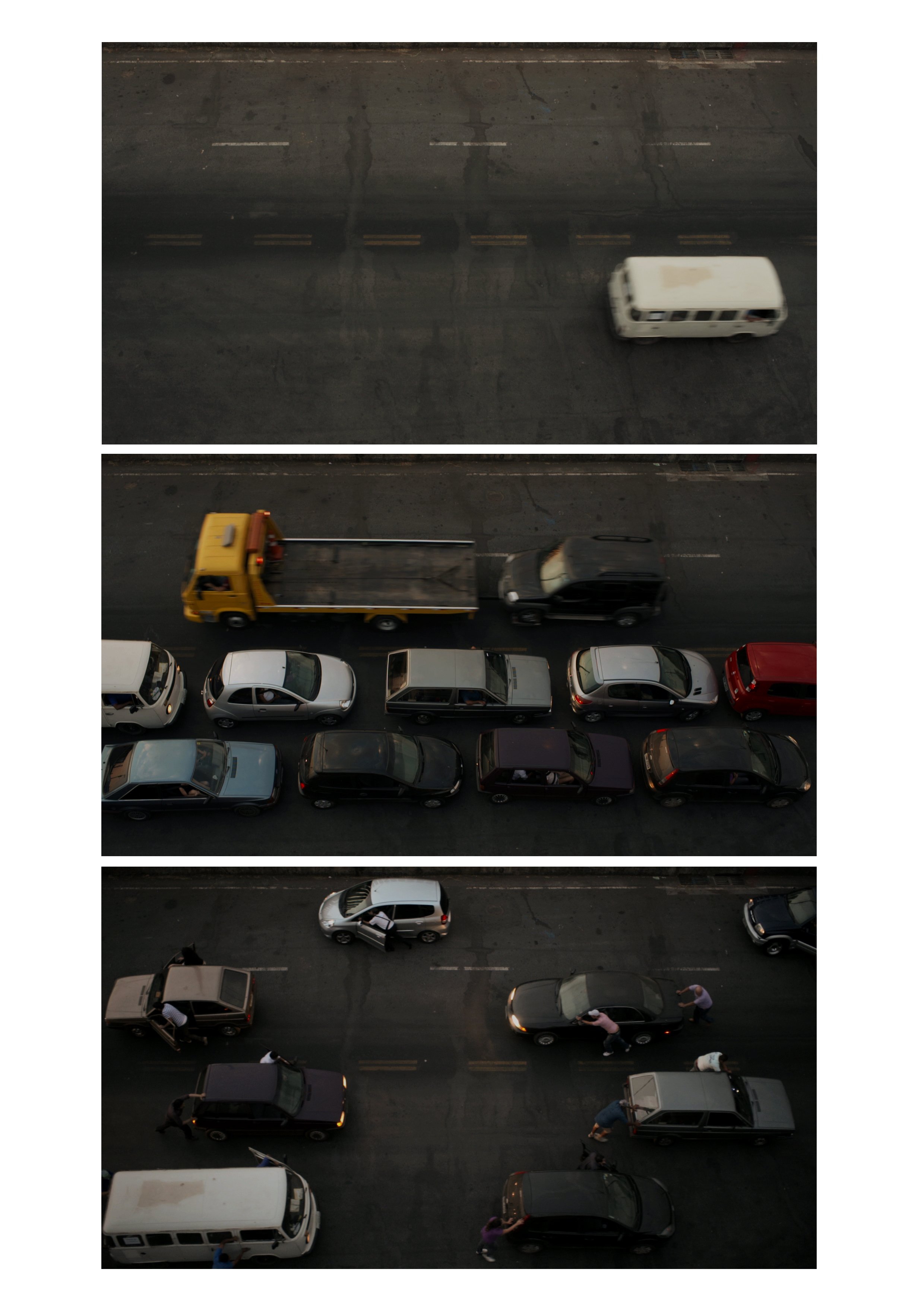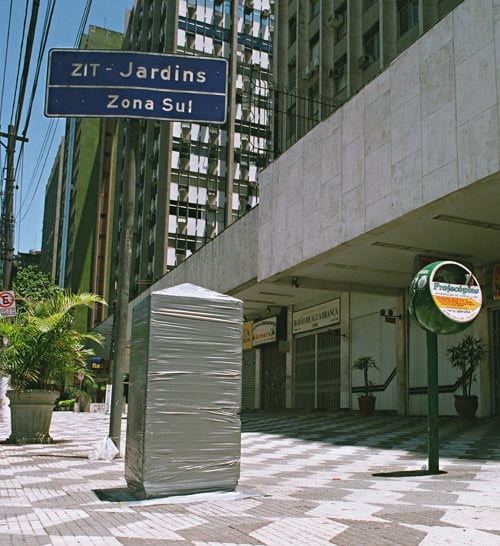
© » KADIST
Marcelo Cidade
Adição por subtração 4 (Addition by Subtraction, 2010) is an intervention into the white cube with both beautiful and intimidating results. The installation is a large rectangular frame created out of shards of clear and colored glass that protrude from the wall. The use of glass fragments is reminiscent of Robert Smithson’s sculpture Map of Glass (Atlantis) (1969), yet the concerns here are very different.

© » KADIST
Rodrigo Braga
Braga’s video work Provisão (2009) opens with a still shot of a clearing in a forest, shoots of grass emerging from a muddy brown patch of seemingly dry and barren earth. As the camera fades to black, the viewer hears the repeated sound of a shovel striking dirt. The camera fades back to the clearing and zooms in on a shirtless man digging up the ground.

© » KADIST
Rivane Neuenschwander
Mapa-Mundi BR (postal) is a set of wooden shelves holding postcards that depict locations in Brazil named for foreign countries and cities. When installed, viewers are invited to fill out and mail a postcard to any destination, an act which parallels the dissemination and global circulation of image, text, and the idea of place.

© » KADIST
Marepe
Marepe (an acronym for Marcos Reis Peixoto) is from northeastern Brazil, and his sculptures and installations are steeped in its culture, traditions, festivals; his personal memories associated with his birthplace; and his interactions with European culture. Periquitos (Parakeets, 2005) is a cartoonlike giant television with a screen made of four vertical strips of blue, yellow, green, and red acetate. There is a recurring figure on the screen, which is taken from a photograph of the artist at age six.

© » KADIST
Carla Zaccagnini
This series of photographs, Sobre la igualdad y las diferencias: casas gemelas (On Equality and Differences: Twin Houses) , taken in Havana in 2005, belongs to a wider group of works that the artist has been developing over many years, generally titled Bifurcaciones y encrucijadas (Forking Paths and Crossroads) . These works are dedicated to the collection and investigation of similarities and singularities. Some focus on things that are supposed or expected to be identical, but end up being slightly different.

© » KADIST
Marcelo Cidade
This series of photographs reflects Marcelo Cidade’s incessant walks or drifting through the city and his chance encounters with a certain street poetry like the Surrealists or Situationists before him. He captures incongruities or everyday simplicity and highlights their suggestive power. The composition and framing of these interventions specially emphasizes the object of interest and the humor of the context.

© » KADIST
Erika Verzutti
Made in cast bronze, Two Eyes Two Mouths provokes a strong sense of fleshiness as if manipulated by the hand of the artist pushing her fingers into wet clay or plaster to create gouges that represent eyes, mouths and the female reproductive organ. Equally, there is a semblance of fruits—their succulence and fragility. While the work is sensual, the matte bronze surface refuses any expectation of softness.

© » KADIST
Clarissa Tossin
In Fordlândia Fieldwork (2012), Tossin documents the remains of Henry Ford’s rubber enterprise Fordlândia, built in 1928 in the Brazilian Amazon to export cultivated rubber for the booming automobile industry. When his rubber trees died from disease and his primarily indigenous workforce revolted, his enterprise went busts within a few short years. Ford never faulted his own planning, but instead blamed the “inhospitable” Brazilian landscape.

© » KADIST
Alexandre da Cunha
His Deck Painting I recalls the simplistic stripes of conceptual artist Daniel Buren, or the minimal lines of twentieth century abstract painting, but is in reality a readymade, fashioned from repurposed fabric of deck chairs. Alexandre da Cunha reinvents found objects in surprising ways that combine the material characteristics of Arte Povera with the concerns and techniques of painting. Da Cunha’s work often features flags—either as a found material per se or as a constructed form—that reflect the artist’s interest in issues of nationality, governmental politics, allegiance, and culture.

© » KADIST
Fernanda Gomes
For this floor based work, Gomes has taken two lengths of bamboo and tied them together using linen thread. The work is self-supporting and stands in a crack or a hole in the floor. The work suggests precariousness, frailty as well as humanity through its verticality, and its gentle sinuous form, referencing perhaps the work of Giacometti.

© » KADIST
Valeska Soares
Relying on repetition and repurposed materials, Soares works to interrogate time—its measurement, its passing, and its meaning. With copper wire stretched out across the room like a clothesline, Valeska Soares’ La Ligne du Temps creates a timeline out of fluttering, old book pages. Read upon the pages of this delicately wrought installation are linguistic approaches to time and its phenomonologies.

© » KADIST
Cildo Meireles
Meireles, whose work often involves sound, refers to Sal Sem Carne (Salt Without Meat) as a “sound sculpture.” The printed images and sounds recorded on this vinyl record and it’s lithographed sleeve describe the massacre of the Krahó people of Brazil. The piece draws on Meireles’s first-hand contact with many indigenous groups through his father’s work with the Indian Protection Service. The recordings on the LP contain narrative accounts of massacres of native peoples, as well as indigenous music and rituals.

© » KADIST
Clarissa Tossin
Clarissa Tossin’s film Ch’u Mayaa responds to Frank Lloyd Wright’s Hollyhock House (constructed 1919–21) in Los Angeles, an example of Mayan Revival architecture. By re-appropriating the structure as a temple and imbuing it with a dance performance based on movements and postures found in ancient pottery and murals, the choreography takes its influence from the house’s design and the body positions on ancient Maya ceramics and buildings. A pulse, breathing, and a pre-Columbian clay flute are among the sounds on the soundtrack.

© » KADIST
Marcelo Cidade
450 Hayes Street (excavation site) by Marcelo Cidade is a large scale photograph documenting the artist’s excavation of a parking lot located at 450 Hayes Street in San Francisco, a former section of the city’s Central freeway and current condominium site. The cut shape mirrors the precise shape of the Kadist gallery floor, where the concrete was relocated as part of his residency exhibition entitled Somewhere, Elsewhere, Anywhere, Nowhere. Through this concrete graft, Cidade inextricably links the city with artwork.

© » KADIST
Rivane Neuenschwander
In this video, a parrot chews on seeds printed with punctuation marks. A radio on the shelf in the background broadcasts the news of an unfolding football match. As the game (and video) progresses, the bird eats all of the remaining punctuation.

© » KADIST
Carla Zaccagnini
De sino à sina (From Bell to Fate) is a six-channel sound installation by Carla Zaccagnini exploring the relationship between modern Brazil and its colonial past. The sound installation is made from a recording of the bell at Capela de Nossa Senhora do Rosário dos Homens Brancos, a Baroque-style chapel that is one of the first chapels in Ouro Preto (previously Vila Rica) in the region of Minas Gerais. The work references the execution of José da Silva Xavier (1746-1792), also known as “Tiradentes”.

© » KADIST
Marcelo Cidade
Marcelo Cidade interrogates the city, architecture and urban planning. This architectonic drawing proposes modular possibilities, adaptable variations based on the form of the concrete block (a material which is often actually integrated in his practice). The “re-definition” announced in the title is in construction, in process, under development, in flux.

© » KADIST
Marcelo Cidade
Marcelo Cidade’s sculpture Abuso de poder (Abuse of Power, 2010) is a mousetrap elegantly crafted in Carrara marble. Originally made for the Carrara Biennale in 2010, it re-creates the iconic form down to the piece of cheese waiting for an unsuspecting victim. In this sculpture, Cicade challenges the viewer’s participation and intervention into the artistic object.

© » KADIST
Alexandre da Cunha
Glaze (Savana) (2005) is an assemblage of found materials: a car wheel, a tire, and a wooden plinth of the type traditionally used to display sculpture. It directly engages with the readymade, a subject that Alexandre de Cunha takes up throughout his practice, often inflecting it with a tropical, and South American–inspired materiality and painterly style that could potentially come across as a stereotype. Here, da Cunha transforms the component parts into a composition that highlights often-overlooked materials of artistic production and cultural mass-production.

© » KADIST
Cinthia Marcelle
Cinthia Marcelle’s video work Automóvel (2012) re-edits the mundane rhythms of automotive traffic into a highly compelling and seemingly choreographed meditation on sequence, motion, and time. Shot from an aerial vantage, the camera tracks the daily commute on a small stretch of concrete highway. The camera films the traffic below in short five-second excerpts before blacking out; time begins to collapse as the video shifts between scene, and the hours compress into minutes as daylight quickly turns into night.

© » KADIST
Alexandre da Cunha
In Laissez-Faire (Rainbow Flag) da Cunha has turned a beach towel into both a painting and a flag. Where the printed surface of the towel originally served to enliven this commodity, here the pattern—now stretched and re-presented—suddenly refers to abstract painting’s promises of transcendence. And its crisply painted shape pulls the printed colors into the rectangularity of the canvas and, as da Cunha notes, the graphic iconicity of flags.

© » KADIST
Marcelo Cidade
This series of photographs reflects Marcelo Cidade’s incessant walks or drifting through the city and his chance encounters with a certain street poetry like the Surrealists or Situationists before him. He captures incongruities or everyday simplicity and highlights their suggestive power. The composition and framing of these interventions specially emphasizes the object of interest and the humor of the context.

© » KADIST
Alexandre da Cunha
The series West (Flag 1), West (Flag 3), and West (Flag 6) continues da Cunha’s ongoing exploration of the form’s various vertical, horizontal, and diagonal stripes. Here, da Cunha overlays thick bars of color (blue, green, and red) on photographs of the ocean at sunset with surfers in floating on the horizon. The solid colors contrast with the fading colors reflected in the sunset, and the tilted orientation suggests a familiar California beach scene.
Alexandre da Cunha
- location: London, United Kingdom
- year born: 1969
- gender: male
- nationality: Brazilian
- home town: Rio de Janeiro, Brazil
Carla Zaccagnini
- year born: 1973
- gender: female
- nationality: Brazilian
- home town: Buenos Aires, Argentina
Clarissa Tossin
- location: Los Angeles, California
- year born: 1973
- gender: female
- nationality: Brazilian
- home town: Porto Alegre, Brazil
Cildo Meireles
- location: Rio de Janeiro, Brazil
- year born: 1948
- gender: male
- nationality: Brazilian
- home town: Rio de Janeiro, Brazil
Cinthia Marcelle
- location: Belo Horizonte, Brazil
- year born: 1974
- gender: female
- nationality: Brazilian
- home town: Belo Horizonte, Brazil
Valeska Soares
- location: New York, New York
- year born: 1957
- gender: female
- nationality: Brazilian
- home town: Belo Horizonte, Brazil
Erika Verzutti
- location: Sao Paulo, Brazil
- year born: 1971
- gender: female
- nationality: Brazilian
- home town: São Paulo, Brazil
Fernanda Gomes
- location: Rio de Janeiro, Brasil
- year born: 1960
- gender: female
- nationality: Brazilian
Marepe
- year born: 1970
- gender: Male
- nationality: Brazilian
- home town: Santo Antônio de Jesus, Brasil
-
1970-1979
Cildo Meireles
1975Meireles, whose work often involves sound, refers to Sal Sem Carne (Salt Without Meat) as a “sound sculpture.” The printed images and sounds recorded on this vinyl record and it’s lithographed sleeve describe the massacre of the Krahó people of Brazil...
-
2000-2009
Carla Zaccagnini
2005This series of photographs, Sobre la igualdad y las diferencias: casas gemelas (On Equality and Differences: Twin Houses) , taken in Havana in 2005, belongs to a wider group of works that the artist has been developing over many years, generally titled Bifurcaciones y encrucijadas (Forking Paths and Crossroads) ...
Alexandre da Cunha
2005His Deck Painting I recalls the simplistic stripes of conceptual artist Daniel Buren, or the minimal lines of twentieth century abstract painting, but is in reality a readymade, fashioned from repurposed fabric of deck chairs...
Alexandre da Cunha
2005Glaze (Savana) (2005) is an assemblage of found materials: a car wheel, a tire, and a wooden plinth of the type traditionally used to display sculpture...
Marcelo Cidade
2006This series of photographs reflects Marcelo Cidade’s incessant walks or drifting through the city and his chance encounters with a certain street poetry like the Surrealists or Situationists before him...
Marcelo Cidade
2006This series of photographs reflects Marcelo Cidade’s incessant walks or drifting through the city and his chance encounters with a certain street poetry like the Surrealists or Situationists before him...
Rivane Neuenschwander
2007Mapa-Mundi BR (postal) is a set of wooden shelves holding postcards that depict locations in Brazil named for foreign countries and cities...
Rodrigo Braga
2009Braga’s video work Provisão (2009) opens with a still shot of a clearing in a forest, shoots of grass emerging from a muddy brown patch of seemingly dry and barren earth...
-
2010-2019
Marcelo Cidade
2010Adição por subtração 4 (Addition by Subtraction, 2010) is an intervention into the white cube with both beautiful and intimidating results...
Marcelo Cidade
2010Marcelo Cidade’s sculpture Abuso de poder (Abuse of Power, 2010) is a mousetrap elegantly crafted in Carrara marble...
Alexandre da Cunha
2010In Laissez-Faire (Rainbow Flag) da Cunha has turned a beach towel into both a painting and a flag...
Alexandre da Cunha
2011The series West (Flag 1), West (Flag 3), and West (Flag 6) continues da Cunha’s ongoing exploration of the form’s various vertical, horizontal, and diagonal stripes...
Clarissa Tossin
2012In Fordlândia Fieldwork (2012), Tossin documents the remains of Henry Ford’s rubber enterprise Fordlândia, built in 1928 in the Brazilian Amazon to export cultivated rubber for the booming automobile industry...
Valeska Soares
2012Relying on repetition and repurposed materials, Soares works to interrogate time—its measurement, its passing, and its meaning...
Cinthia Marcelle
2012Cinthia Marcelle’s video work Automóvel (2012) re-edits the mundane rhythms of automotive traffic into a highly compelling and seemingly choreographed meditation on sequence, motion, and time...
Fernanda Gomes
2013For this floor based work, Gomes has taken two lengths of bamboo and tied them together using linen thread...
Marcelo Cidade
2014450 Hayes Street (excavation site) by Marcelo Cidade is a large scale photograph documenting the artist’s excavation of a parking lot located at 450 Hayes Street in San Francisco, a former section of the city’s Central freeway and current condominium site...
Erika Verzutti
2015Made in cast bronze, Two Eyes Two Mouths provokes a strong sense of fleshiness as if manipulated by the hand of the artist pushing her fingers into wet clay or plaster to create gouges that represent eyes, mouths and the female reproductive organ...
Clarissa Tossin
2017Clarissa Tossin’s film Ch’u Mayaa responds to Frank Lloyd Wright’s Hollyhock House (constructed 1919–21) in Los Angeles, an example of Mayan Revival architecture...
Carla Zaccagnini
2018De sino à sina (From Bell to Fate) is a six-channel sound installation by Carla Zaccagnini exploring the relationship between modern Brazil and its colonial past...
